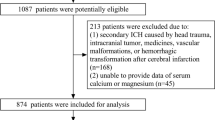Abstract
Background
Prognostic significance of serum calcium level in patients with intracerebral hemorrhage is not well studied. The aim of the study was to identify if a relationship between admission serum calcium level and prognosis exists in patients with intracerebral hemorrhage.
Methods
A total of 1262 confirmed intracerebral hemorrhage patients were included. Demographic data, medical history, medicine history, laboratory data, imaging data, clinical score, and progress note were collected from their medical records. All images of head computed tomography were reanalyzed. Ninety-day prognosis was recorded, and poor outcome was defined as death or major disability caused by intracerebral hemorrhage.
Results
During the 90-day follow-up period, 504 patients died and 226 patients suffered from major disability. Death and major disability were combined as poor prognosis. The remaining 532 patients showed good prognosis. Admission serum calcium level was lower in the patients with poor prognosis than in the patients with good prognosis (2.41 ± 0.23 mmol/l, 2.55 ± 0.26 mmol/l, P < 0.001). Admission INR and hematoma volume were higher in the patients with poor prognosis than in the patients with good prognosis (INR: 1.74 ± 0.29, 1.70 ± 0.29, P = 0.029; hematoma volume: 11.6 ± 4.4 ml, 10.7 ± 4.1 ml, P < 0.001). There was no difference in admission APTT level between the two prognosis groups (28.4 ± 5.6 s, 27.8 ± 5.4 s, P = 0.056). A multivariate COX regression analysis reported that admission serum calcium level ≤ 2.41 mmol/l was associated with the increased risk of poor prognosis (death or major disability) in the patients (HR 1.45, 95% CI 1.32–1.60). In addition, there was a significant linear association of serum calcium level with coagulation function markers and hematoma volume on admission (APTT: r = − 0.091, P = 0.001; INR: r = − 0.063, P = 0.025; hematoma volume: r = −0.108, P < 0.001).
Conclusions
Admission serum calcium level might be a prognostic marker for intracerebral hemorrhage. Potential mechanism involved calcium-induced coagulation function abnormality.


Similar content being viewed by others
References
Keep RF, Hua Y, Xi G. Intracerebral haemorrhage: mechanisms of injury and therapeutic targets. Lancet Neurol. 2012;11:720–31.
Caceres JA, Goldstein JN. Intracranial hemorrhage. Emerg Med Clin N Am. 2012;30:771–94.
Navi BB, Parikh NS, Lerario MP, et al. Risk of intracerebral hemorrhage after emergency department discharges for hypertension. J Stroke Cerebrovasc Dis. 2016;25:1683–7.
Rojo Martínez E, Guerrero Peral AL, Herrero Velázquez S, Núñez García J. Recurrent intracerebral haemorrhage in primary amyloidosis. Neurologia. 2013;28:252–5.
Broderick JP, Brott TG, Duldner JE, Tomsick T, Huster G. Volume of intracerebral hemorrhage. A powerful and easy-to-use predictor of 30-day mortality. Stroke. 1993;24:987–93.
Dowlatshahi D, Demchuk AM, Flaherty ML, Ali M, Lyden PL, Smith EE. Defining hematoma expansion in intracerebral hemorrhage: relationship with patient outcomes. Neurology. 2011;76:1238–44.
Inoue Y, Miyashita F, Toyoda K, Minematsu K. Low serum calcium levels contribute to larger hematoma volume in acute intracerebral hemorrhage. Stroke. 2013;44:2004–6.
Guo Y, Yan S, Zhang S, et al. Lower serum calcium level is associated with hemorrhagic transformation after thrombolysis. Stroke. 2015;46:1359–61.
Morotti A, Charidimou A, Phuah CL, et al. Association between serum calcium level and extent of bleeding in patients with intracerebral hemorrhage. JAMA Neurol. 2016;73:1285–90.
Jackson SP, Nesbitt WS, Kulkarni S. Signaling events underlying thrombus formation. J Thromb Haemost. 2003;1:1602–12.
Triplett DA. Coagulation and bleeding disorders: review and update. Clin Chem. 2000;46:1260–9.
Mupanomunda MM, Ishioka N, Bukoski RD. Interstitial Ca2+undergoes dynamic changes sufficient to stimulate nerve-dependent Ca2+-induced relaxation. Am J Physiol. 1999;276:H1035–42.
Ohwaki K, Yano E, Nagashima H, Hirata M, Nakagomi T, Tamura A. Blood pressure management in acute intracerebral hemorrhage: relationship between elevated blood pressure and hematoma enlargement. Stroke. 2004;35:1364–7.
Barlow P. A practical review of the Glasgow Coma Scale and Score. Surgeon. 2012;10:114–9.
Odderson IR. The National Institutes of Health Stroke Scale and its importance in acute stroke management. Phys Med Rehabil Clin N Am. 1999;10:787–800.
Quinn TJ, Dawson J, Walters MR, Lees KR. Reliability of the modified Rankin Scale: a systematic review. Stroke. 2009;40:3393–5.
Liu J, Wang D, Xiong Y, et al. A cohort study of relationship between serum calcium levels and cerebral microbleeds (CMBs) in ischemic stroke patients with AF and/or RHD. Medicine (Baltimore). 2016;95:e4033.
Wellman GC, Nathan DJ, Saundry CM, et al. Ca2+ sparks and their function in human cerebral arteries. Stroke. 2002;33:802–8.
Llach F, Weidmann P, Reinhart R, Maxwell MH, Coburn JW, Massry SG. Effect of acute and long-standing hypocalcemia on blood pressure and plasma renin activity in man. J Clin Endocrinol Metab. 1974;38:841–7.
Johari V, Loke C. Brief overview of the coagulation cascade. Dis Mon. 2012;58:421–3.
Borah M, Dhar S, Gogoi DM, Ruram AA. Association of serum calcium levels with infarct size in acute ischemic stroke: observations from Northeast India. J Neurosci Rural Pract. 2016;7:S41–5.
Funding
The study was supported by the Natural Science Foundation of China (81560201).The study was supported by the Doctor Foundation of Guizhou Provincial People’s Hospital (GZSYBS[2015]03).
Author information
Authors and Affiliations
Contributions
LT, XL, TL, XY, YR, QZ, HY, XQ, Q W, TT, and JT were involved in study concept and design, acquisition of data, analysis and interpretation of data, and preparation of the manuscript.
Corresponding author
Ethics declarations
Conflicts of interest
The authors declare that they have no conflict of interest.
Rights and permissions
About this article
Cite this article
Tu, L., Liu, X., Li, T. et al. Admission Serum Calcium Level as a Prognostic Marker for Intracerebral Hemorrhage. Neurocrit Care 30, 81–87 (2019). https://doi.org/10.1007/s12028-018-0574-0
Published:
Issue Date:
DOI: https://doi.org/10.1007/s12028-018-0574-0




